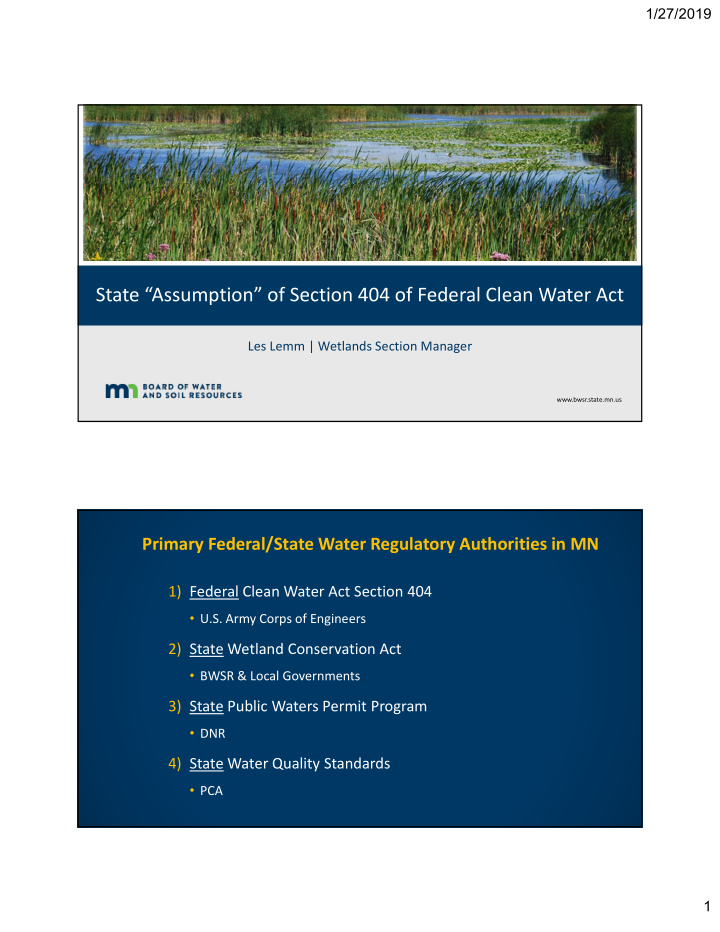



1/27/2019 State “Assumption” of Section 404 of Federal Clean Water Act Les Lemm | Wetlands Section Manager www.bwsr.state.mn.us Primary Federal/State Water Regulatory Authorities in MN 1) Federal Clean Water Act Section 404 • U.S. Army Corps of Engineers 2) State Wetland Conservation Act • BWSR & Local Governments 3) State Public Waters Permit Program • DNR 4) State Water Quality Standards • PCA 1
1/27/2019 What is “404 Assumption?” Section 404 of the Federal Clean Water Act: • Regulates activities in lakes, streams, and wetlands. • Implemented by U.S. Army Corps of Engineers. • Allows state implementation of equivalent program, eliminating the need for separate permits. 33 U.S.C. § 1251(b): “It is the policy of Congress that the States… implement the permit programs under sections 1342 and 1344 of this title.” (1977) 3 What are the benefits of 404 Assumption? Groups interested in assumption have cited the following: Improved permitting timelines/faster processing Reduced regulatory duplication and redundancy Reduced costs for permit applicants More responsive regulatory authorities (state/local vs. federal) 2
1/27/2019 What are the benefits of 404 Assumption? “Section 404 Program Assumption: A Handbook for States and Tribes” (ASWM/ECOS, 2011), also cites the following benefits: More effective resource management drawing on localized expertise. Integration of wetland management with other state programs. Incorporation of state goals and policies into the permit process. Improved regulatory consistency and stability across multiple levels of government. How does 404 assumption affect the protection of our waters and wetlands? • Federal law requires states Separate implement water and wetland State protection measures that are at Regs least as protective as those of Section 404. Comprehensive • 404 assumption = State Regs 1. comprehensive set of state Separate regulations Federal 2. equivalent or greater level Regs of protection 3
1/27/2019 What is the role of the federal government? • EPA must approve state 404 assumption application • EPA oversees state implementation: • Annual reporting requirements • Permit reviews • Review of all potential state statute and rule changes for consistency with 404 • Corps permitting authority eliminated for most waters What has MN done regarding 404 assumption? • 1989 ‐ 1993: Two DNR reports addressing 404 assumption. • 1991/2012: Minn. Stat. §§ 103G.127 and 103G.2375 provide authority to DNR and BWSR to assume 404. • 2015 ‐ present: State agency input to EPA regarding 404 assumption. • 2017: “Minnesota Federal Clean Water Act Section 404 Permit Program Feasibility Study.” • 2018: “Analysis of Retained and Assumable Waters in Minnesota. 4
1/27/2019 Key Findings: Feasibility Study Faster permit decisions, improved efficiency Cost savings to applicants and local governments Must be administered by a state agency/agencies Some statute and rule changes necessary: expanded jurisdiction, exemptions, noticing State and overall non ‐ federal costs would increase What are “assumable waters?” When a state assumes 404, the assumption authority does not apply to all waters; the Corps retains permitting authority over certain waters. • CWA Section 404(g)(1): “…other than those waters which are presently used, or are susceptible to use in their natural condition or by reasonable improvement as a means to transport interstate or foreign commerce shoreward to their ordinary high water mark, including all waters which are subject to the ebb and flow of the tide shoreward to their mean high water mark, or mean higher high water mark on the west coast, including wetlands adjacent thereto...” 5
1/27/2019 Previous Findings: Assumable Waters Analysis 1) Very few waters and wetlands to assume (except for headwater streams and ditches). 2) The process to identify them would be impracticable. Previous Findings: Assumable Waters Analysis Central Minnesota Example Shades of Red = Corps ‐ retained Shades of Blue = State ‐ assumable 6
1/27/2019 Previous Findings: Assumable Waters Example of implementation complications. Shades of Red = Corps ‐ retained Shades of Blue = State ‐ assumable What’s changed? 1) Assumable Waters Subcommittee recommendations to EPA a) A reasonable amount of waters to assume b) A known status of waters, identified and mapped programmatically 2) 2018 Corps memo adopting subcommittee recommendations 3) EPA 404 assumption rulemaking 7
1/27/2019 Rivers and Harbors Significant Changes to Act Section 10 Waters Assumable Waters Corps ‐ retained waters = 1) “Section 10” waters* 2) adjacent wetlands to administrative boundary (e.g. 300 feet) *Except those listed for historic use only The state can assume 404 authority over all other waters and wetlands. What do the changes mean for Minnesota? • Removes the most significant barrier to 404 assumption (assumable waters). • Additional changes to federal rules are expected to make 404 assumption more feasible. • Substantial interest in 404 assumption amongst Minnesota stakeholders. • Greater clarity allows for more informed decision ‐ making. 8
1/27/2019 404 assumption requirements and process. Basic requirement: State program(s) must be at least as protective as Section 404, and the state must have the legal authority and staffing capacity to implement it. Application contents: • Complete description of the state’s regulatory program(s). • Copies of state statutes and regulations. • MOAs with EPA and the Corps. • Attorney General’s statement of authority. If a final decision is made by the state to assume, the application is submitted to EPA along with a letter from Governor requesting program approval. Next Steps in Process Interagency coordination (BWSR, DNR, PCA) Negotiations with EPA Stakeholder outreach and coordination Specific, targeted statute and rule changes Funding for application development and program implementation 9
1/27/2019 Thank You! Les Lemm les.lemm@state.mn.us 651 ‐ 296 ‐ 6057 1/28/2019 www.bwsr.state.mn.us 19 10
Recommend
More recommend